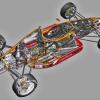My questions are: Why did MacArthur switch to the more temperamental two-strokes? And why would the second car be Mackson 500cc F-3-based, when the first car seems so much more 'state of the Formula Junior art' ?
I'm intrigued that the Mackson-based car came before the 'bespoke' FJ second car and not vice-versa. Thoughts, anyone?
The Mackson-based car in 1960:

(Picture credit: formel3guide.com)
The existing (first?) car in Copenhagen 2006:

Unfortunately I only got to speak very briefly with the car's current owner (and I didn't carry my camera with me the whole time as I should have done in order to get some proper photos, but I'll try to chase more on this little-known Junior).
Does anyone on TNF know more about the Saxons or C. Scott-MacArthur?

























